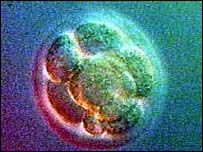Avi Blizovsky

In the picture: some of the spermatozoa formed primary embryos
Direct link to this page: https://www.hayadan.org.il/spermstem.html
Scientists believe they have succeeded in creating working sperm cells from cells taken from another part of the body. The cells were able to "fertilize" a mouse egg and began the process of creating an embryo.
It has now been safely proven that stem cells can be a source of essential sperm cells for infertile men, although scientists believe this is still many years away. A British expert says that there is no certainty that these embryos created can also divide normally.
A large number of men either cannot produce sperm or have lost the ability to do so as a result of medical treatment. For many, the only chance they have of having a child is to use a donor's sperm - there is no chance they will become fathers themselves.
One of the possible answers is to use stem cells - the progenitor cells of the body, which under the right conditions can become any needed tissue. The richest source of these cells is now in fetuses, although such cells may survive in the body throughout life.
The scientists believe that, in theory, some specialized types of stem cells could become sperm cells.
The latest study, from the Whitehead Institute for Biomedical Research in Cambridge, Massachusetts, in collaboration with Boston Hospitals and Harvard University, took stem cells from an area in early mouse embryos known to be the source of "primary germ cells."
These cells will eventually develop into complete sperm cells necessary for the reproduction of the embryo. The researchers isolated the right type of embryonic cells, and succeeded in producing a renewed and continuous line of germ cells in the laboratory - similar to those found in the testicles of mice. In addition, they found a way to encourage these cells to become sperm cells. These cells were injected into the eggs of mice and started the first stage of fertilization. In half of the experiments, the first division occurred, and in one out of five experiments the embryo managed to develop to the blastocyst stage and produced a ball of cells ready for implantation in the uterus.
In any case, not a single live birth has been achieved so far, and some experts believe that the sperm cells created in this way do not carry all the information necessary to produce a healthy mouse.
Doubts
Prof. Azim Surani from the University of Cambridge said that in addition to the genes themselves, each cell also has information as to which genes will work and which will not and at what essential stage of development. "There is no evidence from all the studies for the presence of such a 'tag'. Without the tag, the function of the cell will not be normal. Germ cells can be produced - the problem at the moment is the missing details. We don't have full control over the system now." He concludes. And adds that therefore the use of the process in humans is still far away.
They knew the stem cells
For news at the BBC
https://www.hayadan.org.il/BuildaGate4/general2/data_card.php?Cat=~~~709806634~~~36&SiteName=hayadan
